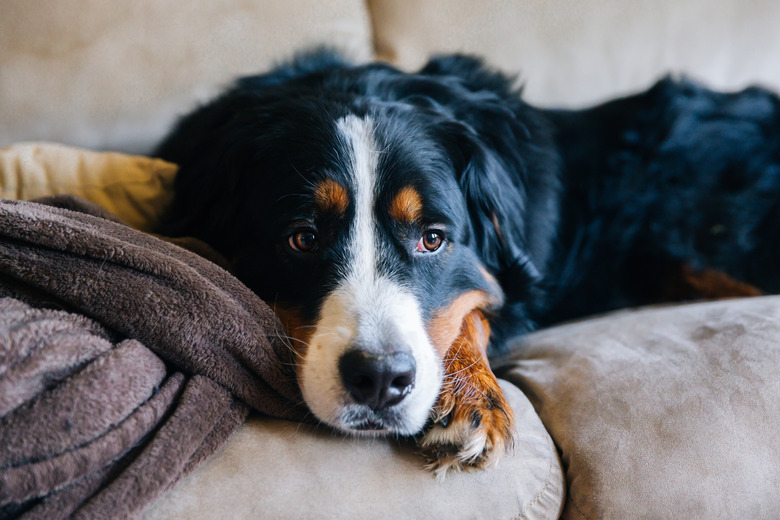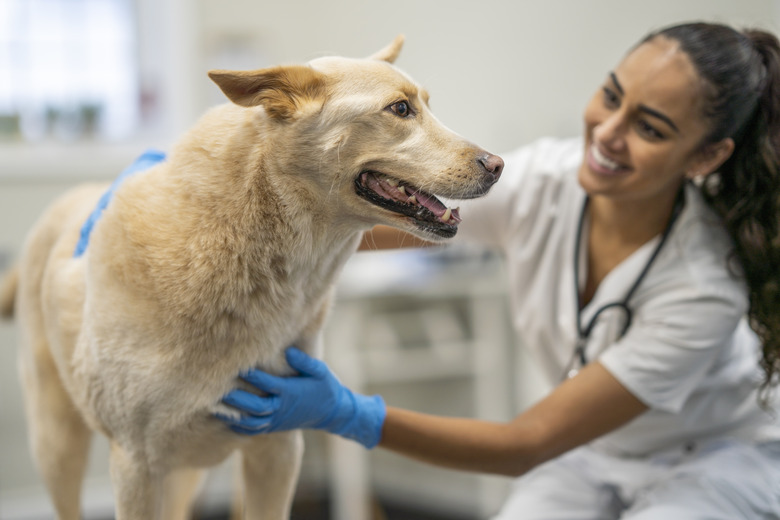Symptoms After A Dog Is Spayed
A spay (ovariohysterectomy) is the neuter surgery that removes a female dog's ovaries and uterus under general anesthesia. Though the word "neuter" is typically associated with male dogs, the term is actually a general one that refers to the castration of male dogs and the spaying of female dogs.
Most young dogs bounce back after their spay/neuter procedure within a few days, but the incision site takes weeks to heal. During this recovery time, there are possible complications that pet owners should watch for. A dog may show signs of pain, an infection can set in, or a dog can have a reaction to the sutures.
What to expect after spaying a dog
What to expect after spaying a dog
The day your pet goes home, you can expect her to:
- Be a bit wobbly on her feet
- Not be interested in eating or drinking
- Sleep most of the evening
The following day, she should be more alert and more interested in eating and drinking. She should not be wobbly on her feet at this point. If she is or if you are concerned about anything she is or isn't doing, call your veterinarian right away.
How common are complications after a dog’s spay?
How common are complications after a dog's spay?
Complications are common after a spay surgery:
- The incision can open: It's common for dogs to lick their incision site after surgery. This can cause the incision to open. If your dog starts to lick her incision at all, she will need to wear an Elizabethan collar (e-collar) for at least a week and possibly longer. It's also common for young dogs to become too active too soon after being spayed. This can cause the stitches to break. If your pup gets the zoomies during the first two weeks after surgery, you'll have to either confine her to a small room or have her spend more time in a crate. To prevent her from running around when going outside to urinate or defecate, keep her on a leash even if it's in your yard.
- Side effects from pain medication: Though most dogs tolerate the typical pain medication sent home after a spay (an NSAID, such as carprofen), it's not unusual for some pups to have decreased appetite, vomiting, or diarrhea. If your dog experiences any of these side effects, stop the medication and call your veterinarian.
- Longer recovery time: This is more common in dogs who are older when spayed, dogs who are spayed while they're in the bleeding part of their heat cycle, or dogs who have an emergency spay due to a pyometra (a life-threatening uterine infection). Dogs spayed while they're in heat can have more internal bleeding during the spay. This can cause a longer recovery. A dog with a pyometra is more likely to have complications because she is sick from infection and her system is already compromised.
- Suture reaction: This is a less common complication and one that cannot be predicted unless a dog has had a reaction before. If a dog is allergic to the suture used to sew up her abdomen after a spay, the incision will take longer to heal. As the sutures start to dissolve one to two weeks after surgery, the skin around the incision will become red and swollen. The inflammation can last for weeks, and there may be discharge as well. These dogs may need antibiotics, an anti-inflammatory, and in some cases, surgery.
Warning signs after spaying a dog
Warning signs after spaying a dog
As with any surgery, complications can occur after a dog is spayed. Post-surgery signs to watch for that can indicate a serious problem are:
- The edges of the incision start to separate.
- There's blood or other fluid at the site of the incision.
- Your dog is unusually listless.
- She shows little or no interest in eating or drinking water the day after surgery or beyond.
- She has a fever.
- She vomits or has diarrhea.
- She's breathing heavier or faster than normal.
- Her gums are pale.
- She displays signs of pain when she is handled, like growling, crying, or snapping.
- The area surrounding her sutures becomes increasingly red, bruised, or swollen.
Signs of infection after a dog’s spay
Signs of infection after a dog's spay
Signs of infection include:
- Longer recovery period
- Not interested in eating or drinking
- The edges of the incision coming apart
- Bleeding or discharge from the incision
Pain as a symptom after a dog's spay
Pain as a symptom after a dog's spay
After spaying, your dog is likely to experience some level of pain. Some dogs behave normally within hours of surgery. Others whimper, cry, pace, moan, and try to bite the incision for several days afterward. Most dogs fall between these two extremes.
Discuss pain medication options with your veterinarian before the surgery. Veterinarians suggest giving pain medication after surgery to prevent a pain spiral. This keeps your dog more comfortable and helps her heal. Only give the recommended dosage.
Excess activity as a symptom after a dog's spay
Excess activity as a symptom after a dog's spay
Your dog may take the pain medication your veterinarian has prescribed and feel so little pain that she becomes too active too soon. If this happens, she can damage her incision, increasing the chances of infection.
In this instance, pain is what alerts her to the fact that she has an incision or an irritated one. Check your dog's incision daily after spaying and check with your veterinarian if your dog seems overly active.
Long-term complications after a dog’s spay
Long-term complications after a dog's spay
Some dogs experience long-term effects that are not desired changes. Hormonal changes occur in dogs who have had their reproductive organs removed. Essentially, they're being put into menopause. Long-term complications include:
- Weight gain
- A decrease in stamina
- Urinary incontinence, which usually doesn't happen immediately after the surgery but months or years later because of low estrogen levels. Estrogen helps control urinary sphincter muscles. If your dog loses control of urine unexpectedly, contact your veterinarian.
- Some dogs experience ovarian remnant syndrome, which is when part of an ovary is inadvertently left behind during a spay. These dogs will continue to have signs of going into heat once or twice a year because a small remnant of an ovary is enough to cause a dog to cycle like an unspayed dog.
The bottom line
The bottom line
As with any surgery, female dogs can experience complications after being spayed. Minor swelling is to be expected, and your dog may not feel like doing much for a couple days. But if you observe bleeding or other discharge from the incision, if she's whining in pain, or if the incision is opening, she may have an infection. To reduce the chances of complications, follow all of your veterinarian's aftercare instructions. If you have any concerns about your pet's health after surgery, contact your veterinarian right away.


